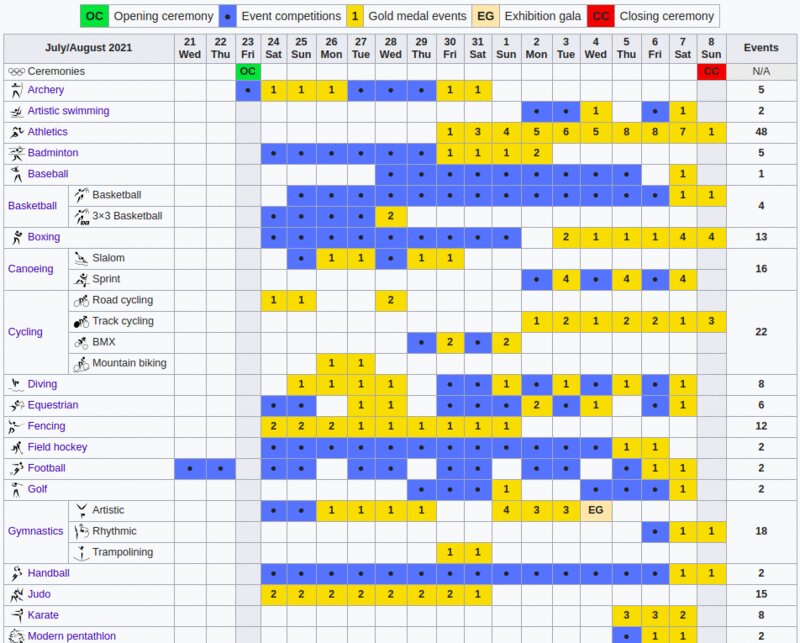Understanding the Olympic Schedule: Breaking At The Summer Olympics Schedule

The Olympic Games are a massive undertaking, requiring careful planning and coordination to ensure a smooth and successful event. At the heart of this organization lies the Olympic schedule, a complex tapestry that weaves together diverse sports, athlete needs, and spectator expectations.
The Importance of a Well-Structured Schedule
A well-structured Olympic schedule is crucial for athletes, organizers, and spectators alike. For athletes, it provides a clear framework for their training and competition, allowing them to optimize their performance. For organizers, it facilitates efficient resource allocation, logistics, and event management. And for spectators, it enables them to plan their viewing experience, ensuring they don’t miss their favorite events.
Challenges of Creating the Olympic Schedule
Creating an Olympic schedule that satisfies all stakeholders is a challenging endeavor. Here are some of the key considerations:
- Accommodating Diverse Sports: The Olympics feature a wide range of sports, each with unique time requirements, venues, and equipment needs. The schedule must be flexible enough to accommodate these diverse demands.
- Time Zone Considerations: The Olympics are held in different time zones, which can create scheduling conflicts for athletes and spectators. Organizers must carefully consider the impact of time differences on event timing and broadcast schedules.
- Athlete Needs: Athletes require adequate rest and recovery time between events, especially in multi-disciplinary sports. The schedule must balance the need for competitive opportunities with athlete well-being.
- Spectator Expectations: Spectators want to see the most popular events and athletes, and the schedule must cater to their preferences while ensuring fair representation for all sports.
Examples of Past Olympic Schedules and Their Impact
Throughout history, the Olympic schedule has evolved to address various challenges and enhance the overall experience.
- The 1984 Los Angeles Olympics: This Games saw a shift towards prime-time television viewership, with key events scheduled during peak hours to maximize audience engagement. This strategy proved successful, contributing to the Games’ commercial success.
- The 2008 Beijing Olympics: The organizers implemented a “clustered” schedule, grouping similar sports together to create thematic blocks. This approach provided spectators with a more focused and immersive experience, enhancing the overall viewing enjoyment.
- The 2016 Rio Olympics: This Games introduced a “flexible” schedule, allowing athletes to compete in multiple events within a shorter timeframe. This innovation aimed to reduce athlete fatigue and increase the number of competitive opportunities, ultimately contributing to a more exciting and unpredictable Games.
Analyzing “Breaking” Events at the Olympics

Breaking, a dynamic and expressive dance style that originated in the streets of New York City, has captivated audiences worldwide and earned its place as a new Olympic sport. Its inclusion in the Tokyo 2020 Games marked a significant moment in the evolution of the Olympics, demonstrating the organization’s commitment to embracing diverse forms of athleticism and artistic expression.
Factors Contributing to the Popularity of “Breaking”, Breaking at the summer olympics schedule
Breaking’s popularity as an Olympic sport can be attributed to several key factors. Its energetic and visually captivating nature makes it incredibly engaging for spectators. The intricate footwork, acrobatic moves, and dynamic power moves create a visually stunning spectacle that draws in audiences of all ages. Furthermore, the sport’s roots in street culture and its association with youth subcultures have made it relatable and accessible to a wide range of viewers.
Comparison of “Breaking” with Other Olympic Dance Styles
Breaking’s competitive format differs significantly from other Olympic dance styles, such as ballroom dancing and rhythmic gymnastics. While the latter focus on precision, elegance, and technical execution, breaking emphasizes improvisation, creativity, and personal expression. Breaking competitions involve head-to-head battles where dancers showcase their unique skills and styles, often incorporating elements of music, storytelling, and cultural references. This improvisational nature sets breaking apart from other structured dance forms, adding an element of unpredictability and excitement to the competition.
The Significance of “Breaking” in Promoting Inclusivity and Diversity
Breaking’s inclusion in the Olympics has played a significant role in promoting inclusivity and diversity within the Games. The sport has traditionally been associated with marginalized communities and has provided a platform for individuals from diverse backgrounds to showcase their talents and perspectives. Breaking’s emphasis on individual expression and creativity fosters a sense of belonging and empowers dancers to embrace their unique identities. By welcoming breaking into the Olympic family, the Games have demonstrated their commitment to celebrating the rich tapestry of human expression and fostering a more inclusive and representative sporting landscape.
The Impact of “Breaking” on the Olympic Schedule

The inclusion of “breaking” in the Olympic Games has undoubtedly shaken up the traditional schedule, adding a fresh, energetic beat to the Games. This new addition has not only expanded the range of sports but has also brought with it a unique energy and a chance to attract a new generation of fans.
The Influence on the Olympic Schedule
“Breaking” has found its place in the Olympic schedule, joining the existing dance disciplines, bringing a unique style and energy to the Games. The addition of “breaking” has prompted a re-evaluation of the schedule, leading to adjustments to accommodate this dynamic new sport.
Attracting New Audiences and Generating Excitement
“Breaking” has the potential to attract a wider audience, particularly among younger generations, who are drawn to its vibrant energy and expressive nature. The inclusion of “breaking” in the Olympics has the potential to increase the overall excitement and viewership, especially in regions where “breaking” is already popular.
Breaking Event Schedule at the Upcoming Olympics
Here’s a glimpse into the “breaking” schedule at the upcoming Olympics, showcasing the dates, times, and venues for these exciting events:
| Date | Time | Venue | Event |
|---|---|---|---|
| August 10, 2024 | 10:00 AM – 12:00 PM | Paris Arena | Qualifying Rounds – Men’s & Women’s |
| August 11, 2024 | 1:00 PM – 4:00 PM | Paris Arena | Semifinals – Men’s & Women’s |
| August 12, 2024 | 7:00 PM – 9:00 PM | Paris Arena | Finals – Men’s & Women’s |
Breaking at the summer olympics schedule – The Summer Olympics schedule is a delicate balancing act, carefully crafted to accommodate the demands of athletes and broadcasters alike. However, the recent escalation of tensions between Iran and Israel, as documented in this detailed history of their conflict , casts a shadow over the games.
The potential for political fallout, even in the midst of sporting competition, is a constant concern, and the organizers must be prepared to adapt their schedule if necessary to maintain the safety and security of all involved.
The Summer Olympics schedule is a meticulously crafted tapestry of athletic feats, designed to maximize viewership and maintain a sense of order. But even the most carefully planned events can be disrupted, leaving athletes and spectators alike frustrated. Just as the efficient operation of the Olympics relies on precise timing, so too does the retail giant Costco depend on the smooth functioning of its costco membership card scanners to ensure a seamless shopping experience.
One can only imagine the chaos that would ensue if the scanners malfunctioned, leading to delays and frustration for shoppers. Similarly, a broken schedule at the Olympics could lead to a domino effect of disruptions, impacting the entire event.
